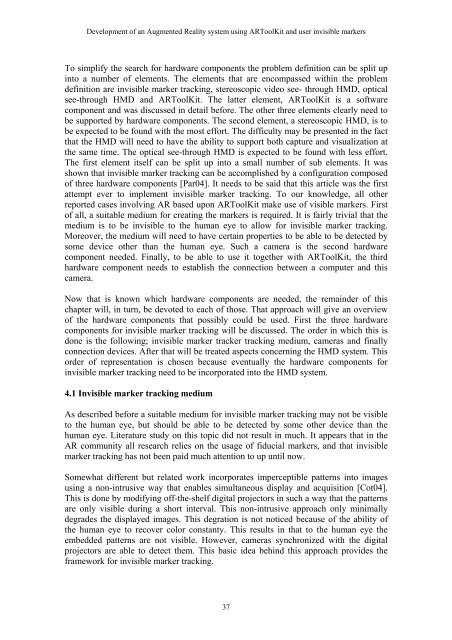Development of an Augmented Reality system using ARToolKit
Development of an Augmented Reality system using ARToolKit
Development of an Augmented Reality system using ARToolKit
Create successful ePaper yourself
Turn your PDF publications into a flip-book with our unique Google optimized e-Paper software.
<strong>Development</strong> <strong>of</strong> <strong>an</strong> <strong>Augmented</strong> <strong>Reality</strong> <strong>system</strong> <strong>using</strong> <strong>ARToolKit</strong> <strong>an</strong>d user invisible markers<br />
To simplify the search for hardware components the problem definition c<strong>an</strong> be split up<br />
into a number <strong>of</strong> elements. The elements that are encompassed within the problem<br />
definition are invisible marker tracking, stereoscopic video see- through HMD, optical<br />
see-through HMD <strong>an</strong>d <strong>ARToolKit</strong>. The latter element, <strong>ARToolKit</strong> is a s<strong>of</strong>tware<br />
component <strong>an</strong>d was discussed in detail before. The other three elements clearly need to<br />
be supported by hardware components. The second element, a stereoscopic HMD, is to<br />
be expected to be found with the most effort. The difficulty may be presented in the fact<br />
that the HMD will need to have the ability to support both capture <strong>an</strong>d visualization at<br />
the same time. The optical see-through HMD is expected to be found with less effort.<br />
The first element itself c<strong>an</strong> be split up into a small number <strong>of</strong> sub elements. It was<br />
shown that invisible marker tracking c<strong>an</strong> be accomplished by a configuration composed<br />
<strong>of</strong> three hardware components [Par04]. It needs to be said that this article was the first<br />
attempt ever to implement invisible marker tracking. To our knowledge, all other<br />
reported cases involving AR based upon <strong>ARToolKit</strong> make use <strong>of</strong> visible markers. First<br />
<strong>of</strong> all, a suitable medium for creating the markers is required. It is fairly trivial that the<br />
medium is to be invisible to the hum<strong>an</strong> eye to allow for invisible marker tracking.<br />
Moreover, the medium will need to have certain properties to be able to be detected by<br />
some device other th<strong>an</strong> the hum<strong>an</strong> eye. Such a camera is the second hardware<br />
component needed. Finally, to be able to use it together with <strong>ARToolKit</strong>, the third<br />
hardware component needs to establish the connection between a computer <strong>an</strong>d this<br />
camera.<br />
Now that is known which hardware components are needed, the remainder <strong>of</strong> this<br />
chapter will, in turn, be devoted to each <strong>of</strong> those. That approach will give <strong>an</strong> overview<br />
<strong>of</strong> the hardware components that possibly could be used. First the three hardware<br />
components for invisible marker tracking will be discussed. The order in which this is<br />
done is the following; invisible marker tracker tracking medium, cameras <strong>an</strong>d finally<br />
connection devices. After that will be treated aspects concerning the HMD <strong>system</strong>. This<br />
order <strong>of</strong> representation is chosen because eventually the hardware components for<br />
invisible marker tracking need to be incorporated into the HMD <strong>system</strong>.<br />
4.1 Invisible marker tracking medium<br />
As described before a suitable medium for invisible marker tracking may not be visible<br />
to the hum<strong>an</strong> eye, but should be able to be detected by some other device th<strong>an</strong> the<br />
hum<strong>an</strong> eye. Literature study on this topic did not result in much. It appears that in the<br />
AR community all research relies on the usage <strong>of</strong> fiducial markers, <strong>an</strong>d that invisible<br />
marker tracking has not been paid much attention to up until now.<br />
Somewhat different but related work incorporates imperceptible patterns into images<br />
<strong>using</strong> a non-intrusive way that enables simult<strong>an</strong>eous display <strong>an</strong>d acquisition [Cot04].<br />
This is done by modifying <strong>of</strong>f-the-shelf digital projectors in such a way that the patterns<br />
are only visible during a short interval. This non-intrusive approach only minimally<br />
degrades the displayed images. This degration is not noticed because <strong>of</strong> the ability <strong>of</strong><br />
the hum<strong>an</strong> eye to recover color const<strong>an</strong>ty. This results in that to the hum<strong>an</strong> eye the<br />
embedded patterns are not visible. However, cameras synchronized with the digital<br />
projectors are able to detect them. This basic idea behind this approach provides the<br />
framework for invisible marker tracking.<br />
37
















